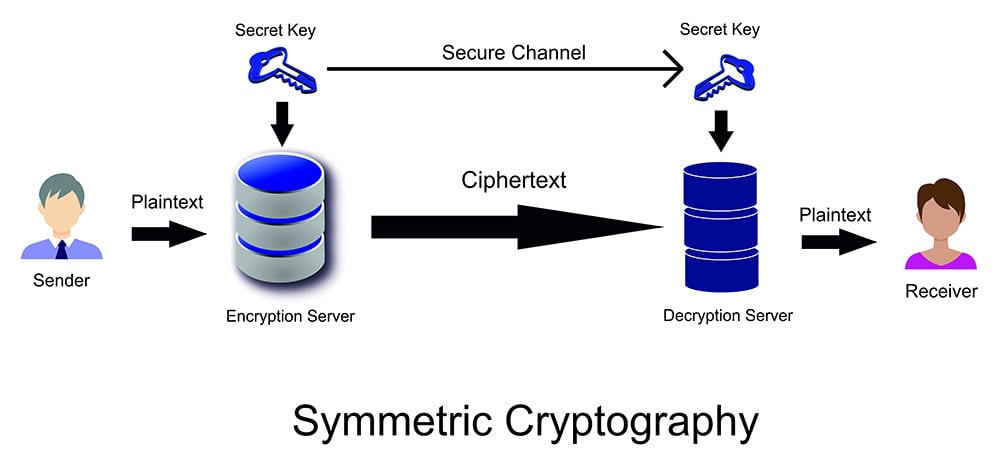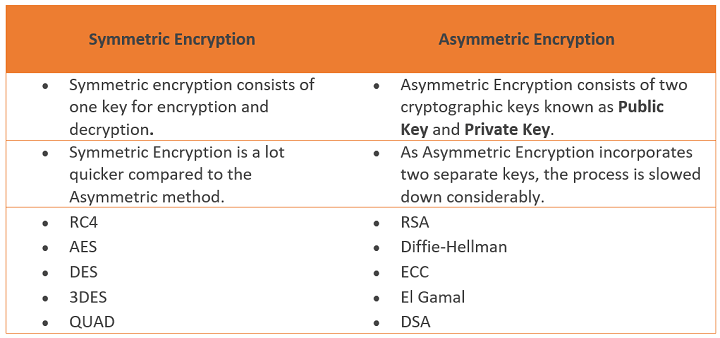Explain How Symmetric Cryptography Different From Asymmetric Cryptography
Symmetric encryption uses the same key to perform both encryption and decryption functions. This ensures the security of asymmetric cryptography making sure only the intended recipient can perform decryption.
Difference Between Symmetric And Asymmetric Encryption Difference Between
See the answer See the answer See the answer done loading.

. Solution for What is the difference between symmetric key cryptography and asymmetric key cryptography. It is much faster and provides confidentiality for large chunks of data. Symmetric encryption uses a.
Asymmetric cryptography uses two keys. Explain how symmetric cryptography different from asymmetric cryptography. If you encrypt with one key you may decrypt with the other.
This is why asymmetric encryption takes a little bit longer than symmetric. Explain three scenarios in which a surrogate key for a relations primary key should be. In Symmetric-key encryption the message is encrypted by using a key and the same key is used to decrypt the message which makes it easy to use but less secure.
Public Key Cryptography or asymmetric cryptography uses two keys to encrypt data. In cryptography two major types of encryption schemes are widely used. On the other hand asymmetric encryption uses the public key for the encryption and a private key is used for decryption.
Symmetric encryption is a simple technique compared to asymmetric encryption as only one key is employed to carry out both the operations. Symmetric encryption where a single secret key is used to encrypt and decrypt data and asymmetric encryption where a public key cryptosystem is used and encryption and decryption is done using a pair of public and corresponding private keyLets explain these fundamental crypto-concepts in details. The encryption process in asymmetric encryption is slower as it uses two different keys.
One method of cryptography is symmetric cryptography also known as secret key cryptography or private key cryptography. There are three primary types of modern encryption. In this case data can be encoded by the public key.
11 rows Difference Between Symmetric and Asymmetric Encryption. It also requires a safe method to transfer the key from one party to another. Asymmetric encryption is used for keys exchange used for symmetric encryption.
We use asymmetric key encryption when we need to transfer only very small amounts of data. What is the difference between symmetric key cryptography and asymmetric key cryptography and how do they differ in terms of how they operate. Asymmetric encryption on the other hand requires the use of two separate keys ie a public key and a private key.
Uses two keys one for encryption and the other for decryption. Encrypted data and keys are exchanged. Symmetric cryptography is best suited for bulk encryption because it is much faster than asymmetric cryptography.
In comparison asymmetric keys are a lot longer sometimes 2048 bits or longer. Symmetric encryption incorporates only one key for encryption as well as decryption. The same key encrypts and decrypts.
Common examples include SSLTLS connections and messaging applications such as Signal Whatsapp that use end-to-end encryption to prevent third-parties and application. Explain the difference between asymmetric and symmetric encryption. Symmetric encryption uses one key.
The fundamental difference that distinguishes symmetric and asymmetric encryption is that symmetric encryption allows encryption and decryption of the message with the same key. Both keys are related to each other through the complicated mathematical process. The main difference between asymmetric versus symmetric cryptography is that asymmetric encryption algorithms make use of two different but related keys.
Symmetric asymmetric and hashing. Hashing is a one-way cryptographic transformation using an algorithm and no key. Asymmetric Encryption consists of two cryptographic keys.
The encryption process of symmetric encryption is faster as it uses a single key for encryption and decryption. Asymmetric key cryptography uses a public-private key pair where one key is used to encrypt and the other to decrypt. Symmetric encryption is mainly used to transmit bulk data.
Uses One key for encryption and decryption. Asymmetric Encryption consists of two cryptographic keys known as Public Key and Private Key. This problem has been solved.
Asymmetric vs symmetric encryption methods both have advantages and disadvantages. One is used for encryption while the other key can decrypts the message. These keys are regarded as Public Key and Private Key.
Symmetric encryption uses shorter keys usually 128 or 256 bits. Unlike symmetric cryptography if one key is used to encrypt that same key cannot decrypt the message rather the. Symmetric encryption consists of one of key for encryption and decryption.
Only the encrypted data is exchanged and the public key is available for anyone. Both parties share the same key which is kept secret. While symmetric encryption uses a single shared key to encrypt and decrypt data asymmetric uses two separate keys.
One key encrypts data and another key decrypts it. Asymmetric Key Encryption is based on public and private key encryption technique. Asymmetric cryptography is not efficient and therefore used only for exchanging a shared key after which the symmetric key is used to.
Symmetric Encryption is a lot quicker compared to the Asymmetric method. Symmetric cryptography is more efficient and therefore more suitable for encryptingdecrypting large volumes of data. What factors need to be taken into account when making a decision on the kind of encryption to be used.
The primary difference between these two types of encryption is that with Symmetric encryption the message to be protected can be encrypted and decrypted using the same key. It takes much longer to encrypt and decrypt a message. Symmetric encryption uses a shared private key while asymmetric.
Difference between Symmetric and Asymmetric encryption. We use symmetric key encryption when we need to transfer large chunks of information and data.

Symmetric Vs Asymmetric Encryption 5 Differences Explained By Experts


Comments
Post a Comment